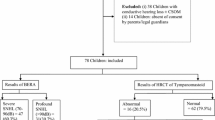Abstract
Autism is the third most common developmental disorder, following mental retardationand cerebral palsy. ASD children have been described more often as beingpreoccupied with or agitated by noise. The aim of this study was to evaluate theprevalence and clinical significance of semicircular canal dehiscence detected on CTimages in ASD children with intolerance to loud sounds in an attempt to find ananatomical correlate with hyperacusis.14 ASD children with auditory hypersensitivity and 15 ASD children without auditoryhypersensitivity as control group age and gender matched were submitted to historytaking, otological examination, tympanometry and acoustic reflex thresholdmeasurement. ABR was done to validate normal peripheral hearing and integrity ofauditory brain stem pathway. High resolution CT scan petrous and temporal boneimaging was performed to all participated children. All participants had normal hearingsensitivity in ABR testing. Absolute ABR peak waves of I and III showed no statisticallysignificant difference between the two groups, while absolute wave V peak andinterpeak latencies I–V and III–V were shorter in duration in study group whencompared to the control group. CT scans revealed SSCD in 4 out of 14 of the studygroup (29 %), the dehiscence was bilateral in one patient and unilateral in threepatients. None of control group showed SSCD. In conclusion, we have reportedevidence that apparent hypersensitivity to auditory stimuli (short conduction time in ABR) despite the normal physiological measures in ASD children with auditoryhypersensitivity can provide a clinical clue of a possible SSCD.


Similar content being viewed by others
References
Geschwind D (2009) Advances in autism. Annu Rev Med 2009(60):367–380 (Review)
Benvenuto A, Moavero R, Alessandrelli R, Manzi B, Curatolo P (2009) Syndromic autism: causes and pathogenetic pathways. World J Pediatr 5(3):169–176 (Review)
Lane A, Young R, Baker A, Angley M (2010) Sensory processing subtypes in autism: association with adaptive behavior. J Autism Dev Disord 40(1):112–122
Monville D, Nelson N (1994) Parental viewpoints on change following auditory integration training for autism. Am J Speech-Lang Pathol 3:41–53
Berkell D, Malgeri S, Streit M (1996) Auditory integration training for individuals with autism. Education Train Ment Retard Dev Disabil 3:66–70
Rimland B, Edelson S (1994) The effects of auditory integration training in autism. Am J Speech-Lang Pathol 3:16–24
Osterling J, Dawson G (1994) Early recognition of children with autism: a study of first birthday home videotapes. J Autism Dev Disord 24:247–257
Rosenhall U, Nordin V, Sandstrom M, Ahlsen G, Gillberg C (1999) Autism and hearing loss. J Autism Dev Disord 29(5):349–357
Tharpe A, Bess F, Sladen D, Schissel H, Couch S, Schery T (2006) Auditory characteristics of children with autism. Ear Hear 27(4):430–441
Rosenhall U, Nordin V, Brantberg K, Gillberg C (2003) Autism and auditory brain stem responses. Ear Hear 24(3):206–214
Courchesne E, Courchesne R, Hicks G, Lincoln A (1985) Functioning of the brain-stem auditory pathway in non-retarded autistic individuals. Electroencephalogr Clin Neurophysiol 61(6):491–501
Rumsey J, Grimes A, Pikus A, Duara R, Ismond D (1984) Auditory brainstem responses in pervasive developmental disorders. Biol Psychiatry 19(10):1403–1418
Chen E, Paladin A, Phillips G, Raske M, Vega L, Peterson D, Sie KC (2009) Semicircular canal dehiscence in the pediatric population. Int J Pediatr Otorhinolaryngol 73(2):321–327
Ceylan N, Bayraktaroglu S, Alper H et al (2010) CT imaging of superior semicircular canal dehiscence: added value of reformatted images. Acta Otolaryngol 130:996–1001
Van Bourgondien M, Mesibov G, Dawson G (1987) Pervasive developmental disorders: autism. In: Wolraich ML (ed) The practical assessment and management of children with disorders of development and learning. Yearbook medical, Chicago, pp 326–351
Dahlgren S, Gillberg C (1989) Symptoms in the first 2 years of life: a preliminary population study of infantile autism. Eur Arch Psychiatry Neurol Sci 238:169–174
Fein D, Skoff B, Mirsky A (1981) Clinical correlates of brainstem dysfunction in autistic children. J Autism Dev Disord 11:303–315
Gillberg C, Rosenhall U, Johansson E (1983) Auditory brainstem responses in childhood psychosis. J Autism Dev Disord 13:181–195
McClelland R, Eyre D, Watson D, Calvert G, Sherrard E (1992) Central conduction time in childhood autism. Br J Psychiatry 160:659–663
Tanguay P, Edwards R, Buchwald J, Schwafel J, Allen V (1982) Auditory brainstem evoked responses in autistic children. Arch Gen Psychiatry 39:174–180
Ceponiene R, LepistT, Shestakova A, Vanhala R, Alku P, Nätäänen R, Yaguchi K (2003) Speechsound-selective auditory impairment in children with autism: they can perceive but do not attend. Proc Natl Acad Sci USA 100(9):5567–5572
Cohen J (1990) Things I have learned (so far). Am Psychol 45:1304–1312
Cohen J (1994) The earth is round (p,05). Am Psychol 49:997–1003
Hoenig J, Heisey D (2001) The abuse of power: the pervasive fallacy of power calculations for data analysis. Am Stat 55:19–24
Cloutier J, Belair M, Saliba I (2008) Superior semicircular canal dehiscence: positive predictive value of high-resolution CT scanning. Eur Arch Otorhinolaryngol 265:1455–1460
Sequeira S, Whiting B, Shimony J et al (2011) Accuracy of computed tomography detection of superior canal dehiscence. Otol Neurotol 32:1500–1505
Modugno G, Brandolini C, Savastio G et al (2005) Superior semicircular canal dehiscence: a series of 13 cases. ORL J Otorhinolaryngol Relat Spec 67:180–184
Conflict of interest
None.
Author information
Authors and Affiliations
Corresponding author
Rights and permissions
About this article
Cite this article
Thabet, E.M., Zaghloul, H.S. Auditory profile and high resolution CT scan in autism spectrum disorders children with auditory hypersensitivity. Eur Arch Otorhinolaryngol 270, 2353–2358 (2013). https://doi.org/10.1007/s00405-013-2482-4
Received:
Accepted:
Published:
Issue Date:
DOI: https://doi.org/10.1007/s00405-013-2482-4




